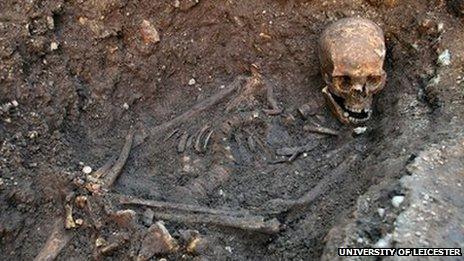Soil samples show Richard III suffered from roundworm
- Published

Soil from the pelvis area of Richard III's skeleton had many roundworm eggs
Richard III suffered from a roundworm infection, a team says.
A soil sample from the region where his infected intestines would have been during life, revealed multiple roundworm eggs.
Prevalent both in medieval times and in tropical countries today, the roundworm parasite spreads from faecal contamination and can grow up to one foot long.
The work is published in the Lancet journal, external.
In addition to soil from the pelvis, scientists tested soil from other areas of the grave to see whether the eggs were equally distributed.
"What we found was plenty of roundworm eggs in the sacral soil, where his intestines would have been. There were no parasite eggs of any kind in the skull soil and only very low levels around the grave," said Piers Mitchell, a medical consultant and researcher at Cambridge University.
"This shows that the significant number of eggs inside the soil must have genuinely been from his intestines and could not have been contamination from soil in the grave."
Discarded human waste
Most soil from medieval times is likely to show some contamination as human waste was often discarded from windows onto the ground below.
Medieval farmers also used faeces as a crop fertiliser which could also have quickly spread the unwelcome guest.
The eggs were identified by powerful microscopes after they had been separated from the soil using sieves. In the right conditions, the dead eggs can be preserved for hundreds of years due to the robust nature of their cell walls.
Roundworms infest the human digestive tract and use the body as a host to stay alive and reproduce. As they steal their host's food, an infection could have resulted in malnutrition or death among people who had extremely poor diets.
Today it is thought a quarter of the population still suffer from roundworm, especially in tropical countries with poor sanitation.
The "king under the car park" was likely to have had an extremely nutritious diet so he may not have noticed many symptoms, apart from a dry cough.
Biological anthropologist Dr Piers Mitchell: "Roundworm is spread from faecal contamination of food"
Common parasites
Many medieval people would have suffered from other intestinal parasites present in meat and fish, but there was no evidence of these in the king's remains.
This suggests that his chefs would have cooked his food very well explained Dr Mitchell.
"Parasites are killed by the thorough cooking of meat, so medieval chefs were perhaps more conscientious than you might otherwise have guessed."
Jo Appleby, at the University of Leicester who helped uncover Richard III's skeleton, said that roundworms were very common at the time.
"It might seem surprising that Richard - who had a very noble background - was infected with roundworm, but this is something that you can pick up very easily through faecal contamination," she told BBC News.
Simon Brooker, at the London School of Hygiene and Tropical Medicine said it was very plausible Richard III had roundworm. He explained that eggs in the pelvic abdominal regions had also been found in other historic sites.
"Where you've got a large number of worms combined with poor nutritional intake, the consequences can be quite severe.
"I expect Richard III's exposure would have been low compared to the people he ruled over. It would have been somewhat of a nuisance rather than having had any severe consequences," Prof Brooker told BBC News.
In February 2013 a team from the University of Leicester said DNA from the bones matched that of descendants of the monarch's family. Since then his distant relatives have been granted a review over the decision to bury his remains in Leicester.